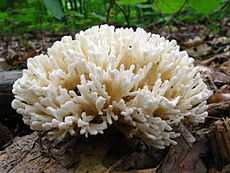Tremellodendron
| Tremellodendron | |
|---|---|
 | |
| Tremellodendron pallidum | |
| Scientific classification | |
| Kingdom: | Fungi |
| Phylum: | Basidiomycota |
| Class: | Agaricomycetes |
| Order: | Sebacinales |
| Family: | Sebacinaceae |
| Genus: | Tremellodendron G.F.Atk. (1902) |
| Type species | |
| Tremellodendron candidum (Schwein.) G.F.Atk. | |
| Species | |
|
Tremellodendron aurantium | |
| Synonyms[1] | |
|
Collodendrum Clem. (1909) | |
Tremellodendron is a genus of fungi in the family Sebacinaceae. Its species are mycorrhizal, forming a range of associations with trees and other plants. Basidiocarps (fruit bodies) are produced on soil and litter. The fruit bodies are clavarioid (club or coral-shaped) and leathery to rubbery-gelatinous. The genus is restricted to the Americas.
Taxonomy
History
The genus was first published in 1902 by American mycologist George Francis Atkinson who had discovered that two species of branched, coral-like fungi previously referred to Thelephora (Tremellodendron candidum and T. schweinitzii) possessed septate basidia, similar to those found in the genus Tremella. He therefore established Tremellodendron to accommodate branched, Thelephora-like fungi with "tremelloid" basidia.[2] A few additional species were described by subsequent authors. Edward Angus Burt, who monographed the genus in 1915, placed Tremellodendron within the Tremellaceae.[3] It remained in this family until 1992, when it was transferred to the newly established Sebacinaceae.[4]
Current status
Molecular research, based on cladistic analysis of DNA sequences, has supported the placement of Tremellodendron within the Sebacinaceae. It has, however, also shown that the genus is polyphyletic and may not be distinct from the genus Sebacina.[5]
Description
Fruit bodies are typically densely branched, the branches erect and leathery to rubbery-gelatinous. In some species the branches tend to fuse together. Colours range from whitish or ochre to brown or reddish brown. Spores are white in mass. Microscopically, the fruit bodies are composed of hyphae lacking clamp connections in a gelatinous matrix. The spore-bearing surface is initially covered in a layer of weakly branched hyphidia below which the basidia are formed. The basidia are tremelloid (ellipsoid and vertically septate), giving rise to long, sinuous sterigmata or epibasidia on which the basidiospores are produced. These spores are ellipsoid to oblong, smooth, and colourless.[6]
Habitat and distribution
Tremellodendron species were assumed to be saprotrophic until DNA analysis of mycorrhizal roots showed that they were plant associates.[5] They are now known to be ectomycorrhizal associates of forest trees.[7] Species are confined to eastern North America,[6] Central America, the Caribbean islands, and South America.[8]
References
- ↑ "Tremellodendron G.F.Atk. 1902". MycoBank. International Mycological Association. Retrieved 2011-01-12.
- ↑ Atkinson GF. (1902). "Preliminary notes on two new genera of Basidiomycetes". Journal of Mycology 8 (2): 106–107. doi:10.2307/3752542.
- ↑ Burt EA. (1915). "The Thelephoraceae of North America. V. Tremellodendron, Eichleriella, and Sebacina". Annals of the Missouri Botanical Garden 2 (4): 731–770. doi:10.2307/2989955.
- ↑ Wells K, Oberwinkler F. (1992). "Tremelloscypha gelatinosa, a species of a new family Sebacinaceae". Mycologia 74 (2): 325–331. doi:10.2307/3792902.
- ↑ 5.0 5.1 Weiss M, Selosse MA, Rexer KH, Urban A, Oberwinkler F. (2004). "Sebacinales: a hitherto overlooked cosm of heterobasidiomycetes with a broad mycorrhizal potential". Mycological Research 108 (Pt 9): 1003–10. doi:10.1017/S0953756204000772. PMID 15506013.
- ↑ 6.0 6.1 Bodman MC. (1942). "The genus Tremellodendron". American Midland Naturalist 27 (1): 203–216. doi:10.2307/2421035.
- ↑ Walker JF, Parrent JL. (2004). "Molecular phylogenetic evidence for the mycorrhizal status of Tremellodendron (Sebacinaceae)". In Cripps CL. Fungi in Forest Ecosystems: Systematics, Diversity, and Ecology. Memoirs of the New York Botanical Garden. New York Botanical Garden Press. pp. 291–296. ISBN 978-0-89327-459-7.
- ↑ Lowy B. (1971). Flora Neotropica 6: Tremellales. New York: Hafner. ISBN 0-89327-220-5.